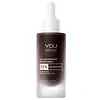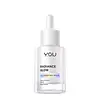What's inside
What's inside
 Key Ingredients
Key Ingredients

 Benefits
Benefits

 Concerns
Concerns

 Ingredients Side-by-side
Ingredients Side-by-side

Water
Skin ConditioningMalic Acid
BufferingButylene Glycol
HumectantPotassium Hydroxide
BufferingGlycerin
HumectantMandelic Acid
AntimicrobialPolyacrylate Crosspolymer-6
Emulsion StabilisingSalicylic Acid
MaskingPanthenol
Skin ConditioningGluconolactone
Skin ConditioningBetaine
HumectantPortulaca Oleracea Extract
Skin ConditioningDiethoxyethyl Succinate
SolventCeramide AP
Skin Conditioning1,2-Hexanediol
Skin ConditioningHydroxyethylpiperazine Ethane Sulfonic Acid
BufferingDipotassium Glycyrrhizate
HumectantPEG-40 Hydrogenated Castor Oil
EmulsifyingGlycolic Acid
BufferingGlyceryl Glucoside
HumectantLactobionic Acid
BufferingLactic Acid
BufferingParfum
MaskingDisodium EDTA
Citric Acid
BufferingTartaric Acid
BufferingCyclodextrin
AbsorbentCeteareth-25
CleansingCI 42090
Cosmetic ColorantCentella Asiatica Extract
CleansingPhenoxyethanol
PreservativeCeramide NP
Skin ConditioningAloe Barbadensis Leaf Water
MaskingCarnosine
Skin ConditioningTocopheryl Acetate
AntioxidantPEG-8
HumectantAlpha-Arbutin
AntioxidantPentylene Glycol
Skin ConditioningPropanediol
Solvent4-T-Butylcyclohexanol
MaskingTranexamic Acid
AstringentOctyldodecanol
EmollientCentella Asiatica Flower/Leaf/Stem Extract
Skin ConditioningCentella Asiatica Root Extract
Skin ConditioningDimethicone
EmollientHydrogenated Lecithin
EmulsifyingSodium Hyaluronate Crosspolymer
HumectantSodium Hyaluronate
HumectantScutellaria Baicalensis Root Extract
AstringentCamellia Japonica Flower Extract
EmollientPolygonum Cuspidatum Root Extract
AntioxidantHydroxyacetophenone
AntioxidantCamellia Sinensis Leaf Extract
AntimicrobialMagnolia Officinalis Bark Extract
AntimicrobialPolyglyceryl-10 Stearate
Skin ConditioningGlycyrrhiza Glabra Root Extract
BleachingChamomilla Recutita Flower Extract
MaskingAscorbic Acid
AntioxidantRosmarinus Officinalis Leaf Extract
AntimicrobialHydrolyzed Sodium Hyaluronate
Skin ConditioningEthylhexylglycerin
Skin ConditioningCholesterol
EmollientPhytosphingosine
Skin ConditioningSodium Acetylated Hyaluronate
HumectantPhospholipids
Skin ConditioningNonapeptide-1
Skin ConditioningHyaluronic Acid
HumectantHydrolyzed Glycosaminoglycans
HumectantCaprylhydroxamic Acid
Ceramide Ns
Skin ConditioningCeramide As
Skin ConditioningHydroxypropyltrimonium Hyaluronate
Potassium Hyaluronate
Skin ConditioningCeramide EOP
Skin ConditioningCI 16035
Cosmetic ColorantCI 77266
Cosmetic ColorantWater, Malic Acid, Butylene Glycol, Potassium Hydroxide, Glycerin, Mandelic Acid, Polyacrylate Crosspolymer-6, Salicylic Acid, Panthenol, Gluconolactone, Betaine, Portulaca Oleracea Extract, Diethoxyethyl Succinate, Ceramide AP, 1,2-Hexanediol, Hydroxyethylpiperazine Ethane Sulfonic Acid, Dipotassium Glycyrrhizate, PEG-40 Hydrogenated Castor Oil, Glycolic Acid, Glyceryl Glucoside, Lactobionic Acid, Lactic Acid, Parfum, Disodium EDTA, Citric Acid, Tartaric Acid, Cyclodextrin, Ceteareth-25, CI 42090, Centella Asiatica Extract, Phenoxyethanol, Ceramide NP, Aloe Barbadensis Leaf Water, Carnosine, Tocopheryl Acetate, PEG-8, Alpha-Arbutin, Pentylene Glycol, Propanediol, 4-T-Butylcyclohexanol, Tranexamic Acid, Octyldodecanol, Centella Asiatica Flower/Leaf/Stem Extract, Centella Asiatica Root Extract, Dimethicone, Hydrogenated Lecithin, Sodium Hyaluronate Crosspolymer, Sodium Hyaluronate, Scutellaria Baicalensis Root Extract, Camellia Japonica Flower Extract, Polygonum Cuspidatum Root Extract, Hydroxyacetophenone, Camellia Sinensis Leaf Extract, Magnolia Officinalis Bark Extract, Polyglyceryl-10 Stearate, Glycyrrhiza Glabra Root Extract, Chamomilla Recutita Flower Extract, Ascorbic Acid, Rosmarinus Officinalis Leaf Extract, Hydrolyzed Sodium Hyaluronate, Ethylhexylglycerin, Cholesterol, Phytosphingosine, Sodium Acetylated Hyaluronate, Phospholipids, Nonapeptide-1, Hyaluronic Acid, Hydrolyzed Glycosaminoglycans, Caprylhydroxamic Acid, Ceramide Ns, Ceramide As, Hydroxypropyltrimonium Hyaluronate, Potassium Hyaluronate, Ceramide EOP, CI 16035, CI 77266
Water
Skin ConditioningPropanediol
SolventPPG-24-Glycereth-24
EmulsifyingButylene Glycol
HumectantMethyl Gluceth-20
HumectantHydroxyethyl Urea
HumectantNiacinamide
SmoothingBis-Ethoxydiglycol Cyclohexane 1,4-Dicarboxylate
EmollientSodium Hexeth-4 Carboxylate
CleansingPropylene Glycol
HumectantBetaine
HumectantCucumis Melo Fruit Extract
Skin ConditioningAcrylates/C10-30 Alkyl Acrylate Crosspolymer
Emulsion StabilisingHydroxyacetophenone
AntioxidantAminomethyl Propanol
BufferingGlycine Soja Seed Extract
Skin ConditioningCorallina Officinalis Extract
Skin ConditioningDipotassium Glycyrrhizate
HumectantDihydroxypropyl Arginine Hcl
HumectantPolymethylsilsesquioxane
Dimethicone
EmollientIsohexadecane
EmollientPEG-40 Hydrogenated Castor Oil
EmulsifyingPentylene Glycol
Skin ConditioningDisodium EDTA
4-T-Butylcyclohexanol
MaskingCaprylhydroxamic Acid
Sodium Hyaluronate
HumectantParfum
MaskingPEG-40 Stearate
EmulsifyingCetearyl Methicone
Skin ConditioningSteareth-2
EmulsifyingSteareth-21
CleansingPhenoxyethanol
PreservativeCaprylyl Glycol
EmollientSodium Benzoate
Masking10-Hydroxydecanoic Acid
Skin ConditioningMagnesium Ascorbyl Phosphate
Antioxidant3-O-Ethyl Ascorbic Acid
Skin ConditioningPrunus Yedoensis Leaf Extract
Skin ConditioningAscorbyl Tetraisopalmitate
AntioxidantWater, Propanediol, PPG-24-Glycereth-24, Butylene Glycol, Methyl Gluceth-20, Hydroxyethyl Urea, Niacinamide, Bis-Ethoxydiglycol Cyclohexane 1,4-Dicarboxylate, Sodium Hexeth-4 Carboxylate, Propylene Glycol, Betaine, Cucumis Melo Fruit Extract, Acrylates/C10-30 Alkyl Acrylate Crosspolymer, Hydroxyacetophenone, Aminomethyl Propanol, Glycine Soja Seed Extract, Corallina Officinalis Extract, Dipotassium Glycyrrhizate, Dihydroxypropyl Arginine Hcl, Polymethylsilsesquioxane, Dimethicone, Isohexadecane, PEG-40 Hydrogenated Castor Oil, Pentylene Glycol, Disodium EDTA, 4-T-Butylcyclohexanol, Caprylhydroxamic Acid, Sodium Hyaluronate, Parfum, PEG-40 Stearate, Cetearyl Methicone, Steareth-2, Steareth-21, Phenoxyethanol, Caprylyl Glycol, Sodium Benzoate, 10-Hydroxydecanoic Acid, Magnesium Ascorbyl Phosphate, 3-O-Ethyl Ascorbic Acid, Prunus Yedoensis Leaf Extract, Ascorbyl Tetraisopalmitate
 Reviews
Reviews

Ingredients Explained
These ingredients are found in both products.
Ingredients higher up in an ingredient list are typically present in a larger amount.
4-T-Butylcyclohexanol has skin soothing and perfuming/masking properties.
A study from 2016 found it to have skin-soothing properties both in-vivo and in-vitro. It works by intercepting the signals of irritation and can soothe the skin in a few minutes.
According to a manufacturer, this ingredient has a scent similar to musk or patchouli. Besides having a skin soothing effect, it can also help cover other unpleasant scents as a masking ingredient.
Learn more about 4-T-ButylcyclohexanolBetaine is a common humectant (a substance that promotes retention of moisture). It's known to be gentle on the skin and can help balance hydration.
This ingredient is best for improving hydration and soothing irritated skin. Studies also show it helps even out skin tone.
Fun fact: Betaine is naturally created in the skin and body. The kind found within cosmetic products can be either plant-derived or synthetic.
Another name for betaine is trimethylglycine.
Learn more about BetaineButylene Glycol (or BG) is used within cosmetic products for a few different reasons:
Overall, Butylene Glycol is a safe and well-rounded ingredient that works well with other ingredients.
Though this ingredient works well with most skin types, some people with sensitive skin may experience a reaction such as allergic rashes, closed comedones, or itchiness.
Learn more about Butylene GlycolCaprylhydroxamic Acid is a chelating agent.
Chelating agents help prevent metal ions from binding to other ingredients. This helps prevent unwanted reactions and effects from using the product.
Caprylhydroxamic Acid is often used with natural antimicrobial products as an alternative to preservatives.
Learn more about Caprylhydroxamic AcidDimethicone is a type of synthetic silicone created from natural materials such as quartz.
What it does:
Dimethicone comes in different viscosities:
Depending on the viscosity, dimethicone has different properties.
Ingredients lists don't always show which type is used, so we recommend reaching out to the brand if you have questions about the viscosity.
This ingredient is unlikely to cause irritation because it does not get absorbed into skin. However, people with silicone allergies should be careful about using this ingredient.
Note: Dimethicone may contribute to pilling. This is because it is not oil or water soluble, so pilling may occur when layered with products. When mixed with heavy oils in a formula, the outcome is also quite greasy.
Learn more about DimethiconeDipotassium Glycyrrhizate comes from licorice root.
Extracts of licorice have demonstrated to have antibacterial, anti‐inflammatory, antiviral, antioxidant properties.
One component, glabridin, has extra potent antioxidant and soothing properties. It has also been found to block pigmentation from UVB rays in guinea pigs.
Licorice Root also contains a flavonoid. Flavonoids are a natural substance from in plants. Flavonoids also have antioxidant properties.
Another component, glycyrrhizin, has been found to have anti-inflammatory and antimicrobial benefits. This may make licorice root extract effective at treating acne. However, more research is needed to support this.
Liquiritin is one of the flavone compounds found in licorice. It has been found to help lighten skin by preventing tyrosinase from reacting with tyrosine. When the two react, protein is converted to melanin. Melanin is the substance in your body that gives your features pigmentation.
Licorice root is native to Southern Europe and Asia. It has been used in traditional Chinese medicine to help with respiratory issues.
Learn more about Dipotassium GlycyrrhizateDisodium EDTA plays a role in making products more stable by aiding other preservatives.
It is a chelating agent, meaning it neutralizes metal ions that may be found in a product.
Disodium EDTA is a salt of edetic acid and is found to be safe in cosmetic ingredients.
Learn more about Disodium EDTAHydroxyacetophenone is antioxidant with skin conditioning and soothing properties. It also boosts the efficiency of preservatives.
This ingredient is not irritating or sensitizing.
Parfum is a catch-all term for an ingredient or more that is used to give a scent to products.
Also called "fragrance", this ingredient can be a blend of hundreds of chemicals or plant oils. This means every product with "fragrance" or "parfum" in the ingredients list is a different mixture.
For instance, Habanolide is a proprietary trade name for a specific aroma chemical. When used as a fragrance ingredient in cosmetics, most aroma chemicals fall under the broad labeling category of “FRAGRANCE” or “PARFUM” according to EU and US regulations.
The term 'parfum' or 'fragrance' is not regulated in many countries. In many cases, it is up to the brand to define this term.
For instance, many brands choose to label themselves as "fragrance-free" because they are not using synthetic fragrances. However, their products may still contain ingredients such as essential oils that are considered a fragrance by INCI standards.
One example is Calendula flower extract. Calendula is an essential oil that still imparts a scent or 'fragrance'.
Depending on the blend, the ingredients in the mixture can cause allergies and sensitivities on the skin. Some ingredients that are known EU allergens include linalool and citronellol.
Parfum can also be used to mask or cover an unpleasant scent.
The bottom line is: not all fragrances/parfum/ingredients are created equally. If you are worried about fragrances, we recommend taking a closer look at an ingredient. And of course, we always recommend speaking with a professional.
Learn more about ParfumPeg-40 Hydrogenated Castor Oil is derived from castor oil and polyethylene glycol (PEG). It is used as a emollient and emulsifier.
As an emulsifier, it helps prevent ingredients from separating. It also helps make the other ingredients more soluble; it is often used to solubilize fragrances. This increases spreadability and elongates shelf life in a product.
Emollients help soothe and soften the skin. They do this by creating a protective film on your skin. This barrier helps trap moisture and keeps your skin hydrated. Emollients may be effective at treating dry or itchy skin.
This ingredient may or may not be vegan, depending on the source.
Peg-40 Hydrogenated Castor Oil may not be fungal-acne safe. We recommend speaking with a professional if you have any questions or concerns.
Learn more about PEG-40 Hydrogenated Castor OilPentylene glycol is typically used within a product to thicken it. It also adds a smooth, soft, and moisturizing feel to the product. It is naturally found in plants such as sugar beets.
The hydrophilic trait of Pentylene Glycol makes it a humectant. As a humectant, Pentylene Glycol helps draw moisture from the air to your skin. This can help keep your skin hydrated.
This property also makes Pentylene Glycol a great texture enhancer. It can also help thicken or stabilize a product.
Pentylene Glycol also acts as a mild preservative and helps to keep a product microbe-free.
Some people may experience mild eye and skin irritation from Pentylene Glycol. We always recommend speaking with a professional about using this ingredient in your routine.
Pentylene Glycol has a low molecular weight and is part of the 1,2-glycol family.
Learn more about Pentylene GlycolPhenoxyethanol is a preservative that has germicide, antimicrobial, and aromatic properties. Studies show that phenoxyethanol can prevent microbial growth. By itself, it has a scent that is similar to that of a rose.
It's often used in formulations along with Caprylyl Glycol to preserve the shelf life of products.
Propanediol is an all-star ingredient. It softens, hydrates, and smooths the skin.
It’s often used to:
Propanediol is not likely to cause sensitivity and considered safe to use. It is derived from corn or petroleum with a clear color and no scent.
Learn more about PropanediolSodium Hyaluronate is hyaluronic acid's salt form. It is commonly derived from the sodium salt of hyaluronic acid.
Like hyaluronic acid, it is great at holding water and acts as a humectant. This makes it a great skin hydrating ingredient.
Sodium Hyaluronate is naturally occurring in our bodies and is mostly found in eye fluid and joints.
These are some other common types of Hyaluronic Acid:
Learn more about Sodium HyaluronateWater. It's the most common cosmetic ingredient of all. You'll usually see it at the top of ingredient lists, meaning that it makes up the largest part of the product.
So why is it so popular? Water most often acts as a solvent - this means that it helps dissolve other ingredients into the formulation.
You'll also recognize water as that liquid we all need to stay alive. If you see this, drink a glass of water. Stay hydrated!
Learn more about Water